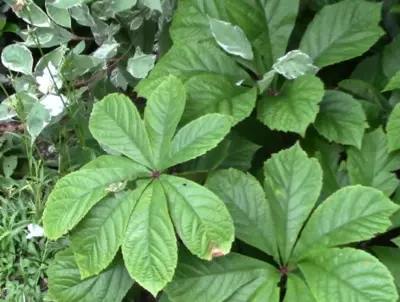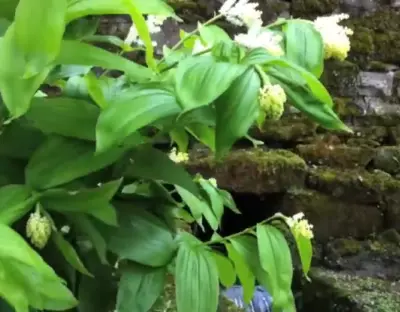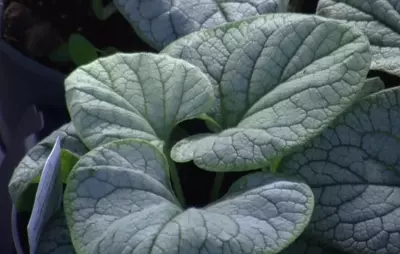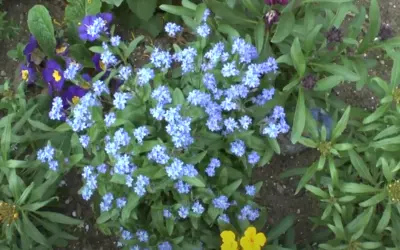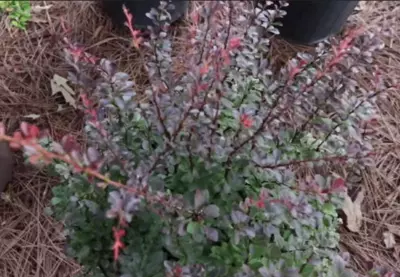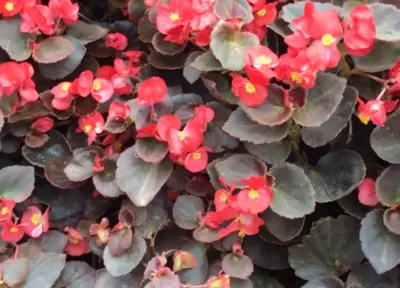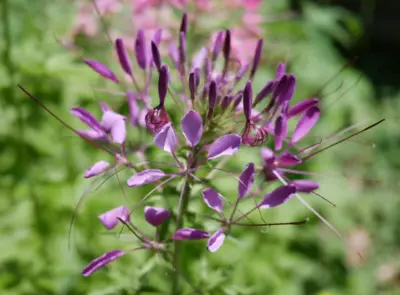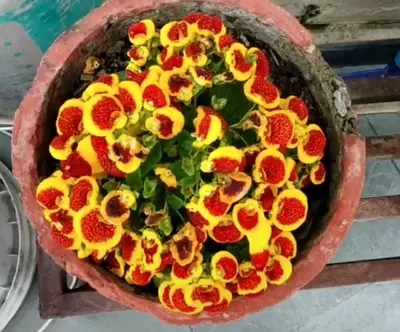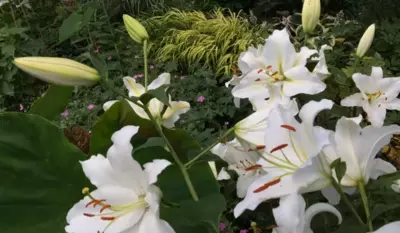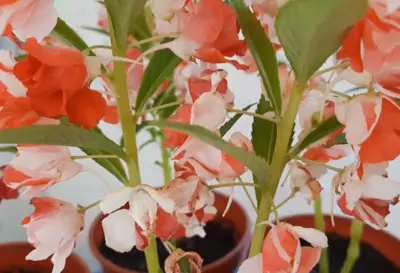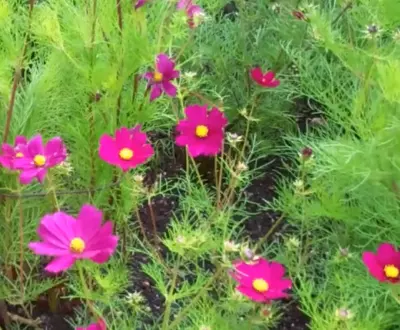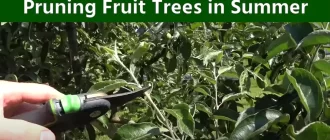Shade-tolerant flowers for the garden, summer flowers that like shade
If desired, even the darkest corners of the garden can be turned into an attractive summer flower bed. Properly selected compositions of shade tolerant flowers will please their owners for several years.
The quality of shade for individual varieties can vary. If some flowers are comfortable on the northern side of the plot, others retain flowering longer in partial or lace shade. Ideally, planted crops should replace each other’s blooms, providing aesthetic pleasure.
Shade-tolerant flowers for the garden perennial bloomers
Plants growing in dense shade are more likely to stand out for the texture of their leaves, rather than their abundant blooms. When planting summer shade-loving flowers, it is important to consider the moisture of the soil and the properties of shrubs and trees growing nearby.
Hosta is a perennial ornamental plant with short-lived blooms in the second half of summer. On a tall stalk, purple bells bloom, gathered in bunches. The foliage of the hosta is of the greatest interest. The elongated wrinkled leaves combine shades of green, white, and blue and are formed into a lush dense cap. The plant retains its colors until the first frost.
Shade-tolerant flowers grow comfortably in any corner of the garden, including under trees. In contact with sunlight, the hosta changes its color. Green varieties lighten, blue leaves turn green. So does the hosta like shade or sun? Resistance to sunlight is determined by the plant variety. Absence of direct sunlight helps keep the leaves lush. The ideal location – near water bodies among dense vegetation.
Rogersia is a shade-tolerant perennial plant with large leaves. Tall shoots perfectly decorate a shady garden. Leaf plates are shaped like chestnut or elderberry leaves.
Flowering falls in early June and lasts 3-4 weeks. The small florets are colored in light delicate tones and emit a pleasant fragrance. After flowering, the leaves sprout with renewed vigor and take on new and interesting colors. Tall summer flowers like shade, so it is better to plant them along fences or buildings.
Primrose – perennial low-growing flowers that grow well in the shade of tall plants. The length of the flower stalk reaches no more than 0.6 ft in height. The coloring of the flowers is very diverse. In some varieties the flowers are gathered in inflorescences, in others they are arranged in a single version.
Primrose in the open ground better takes root in late spring, and already begins to please the beautiful bright blossoms. With proper care, the plant re-blooms in mid-summer and retains its flowers until the end of August.
Smilacina is a perennial plant for shady, moist corners of the garden. First blooms begin in mid-spring and last until mid-summer. The small white flowers resemble fluffy panicles from afar, which don’t wilt but grow into red berries.
The ornamental plant is densely dotted with large leaves that quickly grow and create its own unique design.
Iris sibirica is a perennial plant with many varieties. The flower stems are large, fancifully shaped and fuzzy watercolor. Bright yellow, blue, white flowers will be a bright decoration of a darkened garden at the beginning of the summer season. The flower petals are arranged in 2 tiers and are found in both the same color scheme and different ones.
The unpretentious plant is propagated by rhizomes and is comfortable in any plot of land. Dense green leaves continue their decorative function even after flowering. Shade-tolerant flowers are comfortable on the sunny side as well.
Iris take root both in autumn and spring. Bare rhizomes must be covered with soil before frosts.
Any versatile shade-tolerant flowers should not grow in dense shade for long periods. Therefore, it is recommended to transplant flowers at least once every 3 years.
Garden geraniums are unpretentious perennials with long blooms. A shade-tolerant plant, it quickly grows into a lush bush and likes lots of light. Geraniums like shade or sun? Summer flowers are planted in the shade, so that the sun does not kill the flowers.
Versatile garden geraniums perfectly complement any flower beds. Large inflorescences have many shades. Gardeners often use the plant for a background – shade-tolerant flowers are planted in empty areas between shrubs. Propagate garden geraniums is best by dividing bushes. The hardy plant is quickly adopted and does not require special care.
Dicentre is a moisture-loving summer flower that likes shade. The mottled heart-shaped flowers are arranged in a row on a long arrow. The older the plant, the more abundant and powerful the blooms.
Dicentre blooms in late May and is pleasing to the eye throughout the summer season. Planting in the shade promotes the growth of the shrub and a longer flowering period. Dicentra is propagated by dividing the shrub. It doesn’t need annual replanting, keeping its properties for 5-6 years.
Brunera is a perennial flowering plant that reaches half a meter in height. Its small blue inflorescences remind of forget-me-nots. The shade-tolerant flowers grow spectacularly in thickets. In woodland areas they are found in damp, shaded areas.
At comfortable temperatures, the brunera may re-bloom in the fall. The flower is propagated through the rhizome. Before wintering, the mottled leaves are cut off.
Most shade-tolerant flowers require timely moistening and fertilizing.
Forget-me-nots are unpretentious shade-tolerant flowers with small blue flowers. The abundant flowering creates a carpeting effect and is ideal for filling in gaps in plots. The stem height is no more than 1 ft.
The forget-me-not grows well in the shade of trees and shrubs. To prolong the vitality of the plant, you need to remember to moisten the soil. Flowering begins in spring and ends in late July.
Badanus – summer flowers with dense large leaves, which gardeners often compare to elephant ears. Low-growing perennials grow well in rocky soil and in the shade of woody plants. Care of the plant is to remove the rotted leaves, which are left to overwinter and turn purple at the first frosts.
The flowers of badanum are small bells, which are gathered on a thick stalk. Summer shade-tolerant flowers it is better not to disturb with frequent transplants. The surface root system should be timely watered and protected from drying out.
Barberry is an evergreen unpretentious plant that is densely flocked on the ground. The leaves of the creeping shrub resemble narrow glossy plates. Each year the flowers cover a new meter of ground. To limit its spread but leave a beautiful bloom – plant the flower in a beautiful garden pot.
Active flowering of the periwinkle begins in spring and lasts all summer. Blue, lilac, pink or white five-petaled flowers are woven between the leaves.
Geichera are ideal shade-tolerant flowers for the lazy garden. Caramel and bright lettuce shades of foliage are complemented by marbled patterns with a silvery dusting. Leaf color changes three times from spring to fall.
The perennial flower likes shade and sun. Geichera delights with abundant blooms of white and pink bells. The flower is used for landscaping stony areas of the garden.
Tiarella is a low-growing perennial plant ideal for shady corners of the garden. Small delicate inflorescences are placed in the form of spikelets.
Unpretentious summer flowers like shade and grow quickly in all conditions. They are a worthy alternative to common grass to fill the lawn. Propagate Tiarella by dividing every 3-4 years or by self-sowing.
When combining several varieties of flowers, it is important to observe the order of their growth. Low flowers are planted in the first row to the light. High flowers in the foreground create too dense a shade.
Astilbe is an attractive flower with abundant long blooms. The interesting shape of the leaves keeps the plant decorative even without flowers. Small inflorescences are gathered in dense compositions and shimmer in red, pink and white shades.
Different varieties of astilbe bloom in early, mid and late summer, which allows you to admire the beautiful colors throughout the season. The height of the plant varies from 1 to 5 ft.
The shade-tolerant flowers lose their brightness when exposed to direct sunlight. Adult plants are frost-resistant. Young seedlings should preferably be covered for the winter.
Begonia is an ever-flowering plant complements flowers that like shade. Bright shades of flowers beautifully mottled in hanging pots, in flowerbeds and beds. Produces small compact bushes, so a group planting is required for a beautiful picture.
Begonia is a shade-tolerant and frost-resistant plant. Favorable conditions for her are considered moist environment and rich soil, temperature above 20 degrees. In summer, the flower needs frequent watering. The plant is propagated by dividing the shrub or rhizome.
Lobelia is an annual flower that grows well in lace shade. The small bushes grow in the shape of a ball. Suspending pots with lobelia allows you to form a rounded, weightless composition. Blooms of white, purple and blue flowers begin in late spring and last until fall.
In September, capsules with seeds ripen in place of flowers. Some varieties of lobelia can be propagated only by cuttings.
Nasturtiums are unpretentious summer flowers, growing as low bushes. Lush dense foliage has a rounded shape. Single flowers are colored in warm shades of yellow and red.
Shade-tolerant summer flowers should not be placed in full shade, as you may not wait for flowering. With a lack of light, the stems of the plant become very elongated and the shrub loses its attractiveness.
Shade-tolerant annual flowers
Alyssum is an annual unpretentious plant with abundant mottled blooms. The low-growing shade-tolerant flowers have a bright, pronounced fragrance and are classified as mellifera plants.
Small inflorescences replace each other throughout the summer, thus actively attracting insects. Thick hats of flowers perfectly cover bare spots of soil. Alissum is grown through seedlings and by sowing.
Cleome – unusual summer flowers that love shade. The plant has a powerful root system and reaches 5 ft meters in height. Brushes of inflorescences reach 0.6 ft in diameter and resemble a cobweb. The most common color is white and bright pink.
Flowering lasts from early summer to September. The unusual smell is not to the liking of all gardeners, but it is excellent for deterring pests. It is possible to grow the cleome only with seeds, which mature in mid-autumn.
Flowers planted in the shade of trees need constant moistening and feeding. Otherwise, they will compensate for the lack of nutrients at the expense of nearby growing rhizomes.
Petunia is a low-growing summer plant with large, variegated flowers. The delicate structure of the bells burns from direct sunlight, so the lacy shade will be an ideal place for the unpretentious plant.
Beautiful summer flowers decorate areas until late fall. They are planted along borders or in decorative vases. Petunias require frequent watering. The plant is easily propagated by seeds.
Stonecrop is an undemanding shade-loving plant for the garden. It blooms in July and finishes in early autumn. Flowers of pink, light red and white shades are found.
The shade-tolerant flowers do not grow more than 1 ft in height, but are excellent for enlivening a darkened area. Seedlings are not rooted in the soil until early June. The unpretentious plants grow well in dry soil and do not tolerate stagnant water.
Calceolaria are annual shade-loving flowers that produce abundant blooms on fertilized and moist soil. The unusual shape of the flowers resembles blown slipper flowers, which can be admired in late spring and early summer.
The summer plant quickly loses its decorativeness, so it is recommended to plant new rosettes every year. Calceolaria are summer flowers that like shade and moisture. In dry weather, the plant quickly withers.
Mimulus are annual flowers that love shade and keep blooming all summer long. The low-growing plant is planted along borders. Colorful blooms last until late fall.
The shape of the flower resembles elongated bells with turned out petals at the end. The folk name for the flowers is sponges. The coloring of the flowers is diluted with stripes and strokes. Mimulus tolerates drought well and propagates by self-seeding.
Spectacular summer shade-tolerant flowers for the penumbra
Lilies are spectacular plants with large, fragrant flowers. The abundant flowering is directly dependent on light, but in nature it grows in partial shade. The duration of flowering is not more than one month.
How to understand the lily leaf likes shade or sun? The ideal placement for a flowering bed is semi-shade. Bright colors burn out in the sun, so dark shades should definitely be placed in the shade. Lilies look spectacular in a dense planting separately from other flower compositions. Summer flowers can be planted under vineyards and fruit trees.
Pansies are an annual more commonly found in sunny flowerbeds. To prolong the flowering of the summer plant, it is better to choose a site with semi-shade. Shade-tolerant flowers for the garden will be smaller in size, but will not lose their colors.
Propagate pansies vegetatively or wait until the flowers are sown on their own. The plants bloom throughout the summer and are very reminiscent of house violets.
A garden plot with penumbra should have at least 3 hours of sunlight per day, falling in the morning or evening.
Delphinium is a summer flower with tall flower stalks of variegated shades. The plant is planted both in the shade and in the sun. What does delphinium like shade or sun?
Strong sunlight will cause the petals to burn out, shortening the flowering time. The best place to plant delphinium is on the side where contact with sunlight occurs in the first half of the day. The first flowering is in June-July. With proper pruning, the plant will re-emerge flowers.
Balsamina is an unpretentious summer plant with long blooms. The fleshy stems have dense, green, pointed leaves. Large flowers are placed from bottom to top on an upright arrow. They come in red, purple, and white.
Balsamina does not tolerate direct sunlight and frost. It feels comfortable in the penumbra. In the Southern States of America, the plant blooms year-round. Inside the flower is a fruit-box with seeds that are easily extracted on contact.
Astrancia are perennial summer flowers that like shade, sun and penumbra equally. The unpretentious plant blooms in any soil and will form vigorous clumps if given enough.
Because of its versatility, astrancia is actively used by designers for landscaping plots. The monochromatic inflorescences persist throughout the summer and retain their appearance long after cutting.
Phloxes are dwarf perennial flowers that like the penumbra. The dense inflorescences bloom abundantly in midsummer. The flowers of shrub phloxes are colored in bright juicy colors and emit a pleasant fragrance. Popular colors include red, white and purple. When exposed to sunlight, the flowers blaze with their colors.
Summer phloxes tolerate transplanting well even during flowering and multiply quickly through bush division. If there is a lack of moisture, the leaves quickly turn yellow and the flowers become shallow.
Cosmea is an unpretentious herbaceous plant with lots of greenery. The daisy-shaped flowers are colored in iridescent pink and white. The terry varieties are colored maroon and yellow.
After blooming, the densely planted cosmea shoots resemble a fluffy carpet. Individually planted flowers stretch to 1.5 m in height. The flowering cosmos is well tolerant of cold and grows equally well in the shade and in the sun. Half shade is ideal for this plant.
Viscaria is a summer flower for the penumbra. The short plant has poorly developed foliage, which during the flowering period is completely covered by flowers with delicate shades of pink and blue.
The climbing plant is often used to decorate arbors and balconies. The flowering period is two months. The unpretentious viscaria does not require additional feeding, but needs regular watering.

